Turkey-backed Azeri forces have been accused of inflicting heavy damage on the Armenian Apostolic Church’s Holy Saviour Cathedral in the historic city of Shusha (Shushi).
Images shared by the Armenian government and journalists on the ground show that the 19th-century church, known locally as Ghazanchetsots Cathedral, appears to have been bombarded by artillery, with holes blown in its roof.
The interior of the Christian place of worship has also suffered heavy damage, with pews smashed to splinters and Bibles scattered amidst the rubble.
The cathedral is located in the autonomous Nagorno-Karabakh province of Muslim-majority Azerbaijan, populated largely by ethnically Armenian Christians who declared independence as the Republic of Artsakh in the 1990s.
The bloody war sparked by that declaration of independence ended in something of a stalemate, with Artsakh receiving no international recognition but the tacit support of Armenia and, somewhat less stridently, Russia, while the Azeri government maintained its claims of sovereignty.
That semi-frozen conflict has now once again erupted into violence, with the Turkey-backed Azeris making significant inroads in the province — but Armenians believe that the attack on Ghazanchetsots was punitive in nature, rather than serving any legitimate military purpose.
“There is no military, nothing strategic here, how can you target a church?” a local resident told AFP.
“It is a very important cathedral for Armenians. God will be the judge,” he added.
BILD journalist Paul Ronzheimer confirmed that there was “terrible destruction inside” the cathedral, sharing a short video showcasing some of the damage — but added that, thankfully, “the kids plus parents who were in the basement hiding” escaped injury.
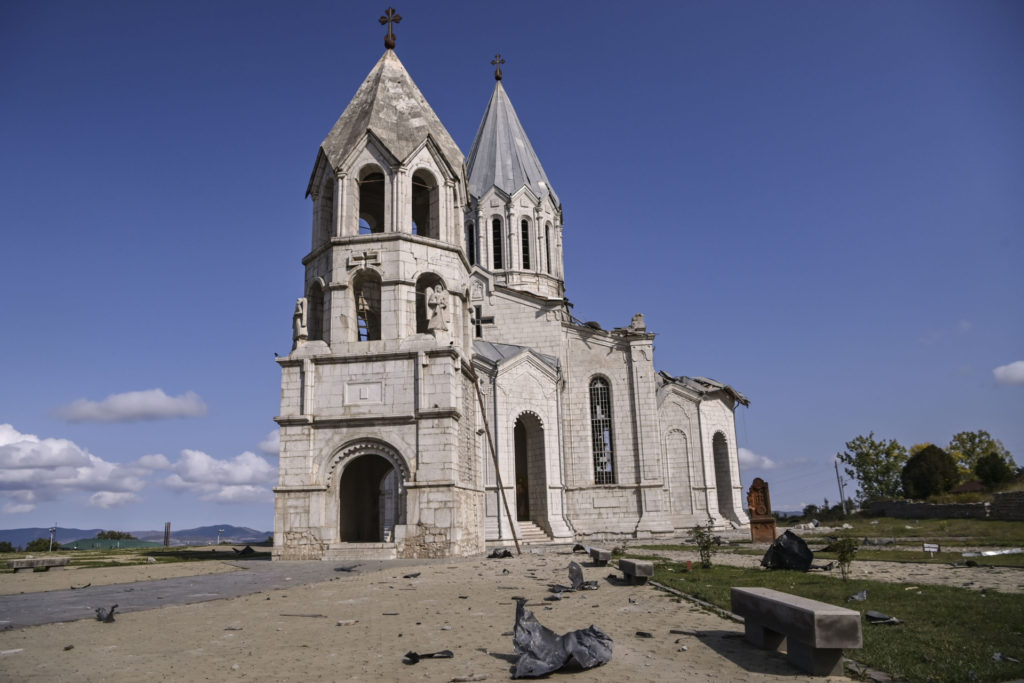
This picture taken on October 8, 2020 shows the damaged Ghazanchetsots (Holy Saviour) Cathedral in the historic city of Shusha, some 15 kilometres from the disputed Nagorno-Karabakh province’s capital Stepanakert, after it was hit by a bomb as fighting between Armenian and Azerbaijani forces spilled over today ahead of a first meeting of international mediators in Geneva. Nagorno-Karabakh broke away from Azerbaijan in a 1990s war that claimed the lives of some 30,000 people. The Armenian separatists declared independence, but no countries recognise its autonomy and it is still acknowledged by world leaders as part of Azerbaijan. (Photo by ARIS MESSINIS / AFP) (Photo by ARIS MESSINIS/AFP via Getty Images)
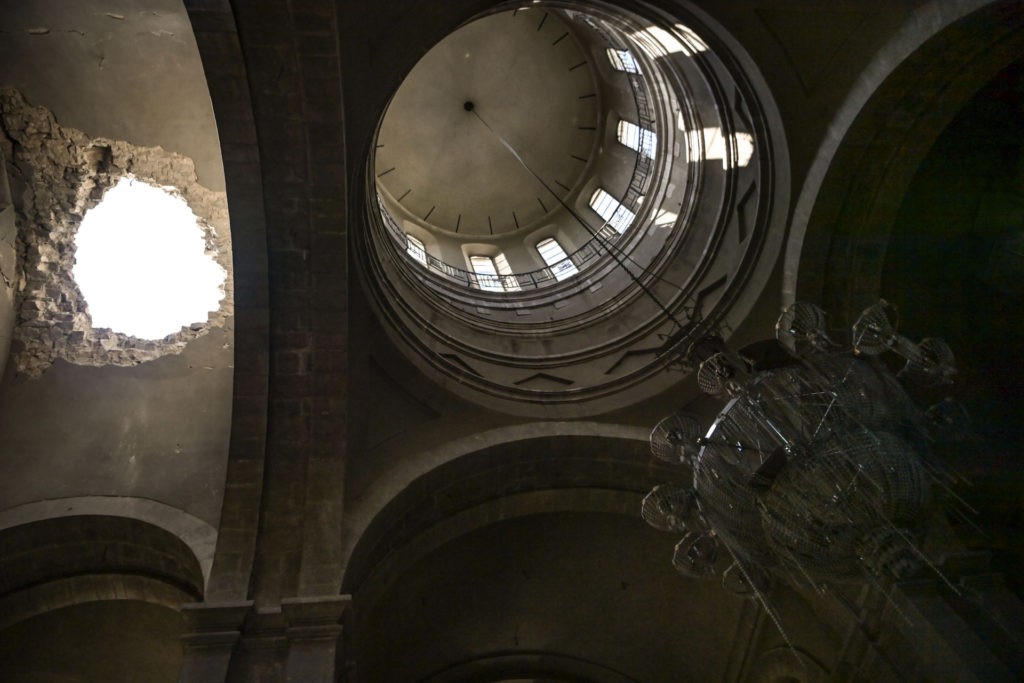
This picture taken on October 8, 2020 shows a hole in the roof of the Ghazanchetsots (Holy Saviour) Cathedral in the historic city of Shusha, some 15 kilometres from the disputed Nagorno-Karabakh province’s capital Stepanakert, that was hit by a bomb as fighting between Armenian and Azerbaijani forces spilled over today ahead of a first meeting of international mediators in Geneva. Nagorno-Karabakh broke away from Azerbaijan in a 1990s war that claimed the lives of some 30,000 people. The Armenian separatists declared independence, but no countries recognise its autonomy and it is still acknowledged by world leaders as part of Azerbaijan. (Photo by ARIS MESSINIS / AFP) (Photo by ARIS MESSINIS/AFP via Getty Images)
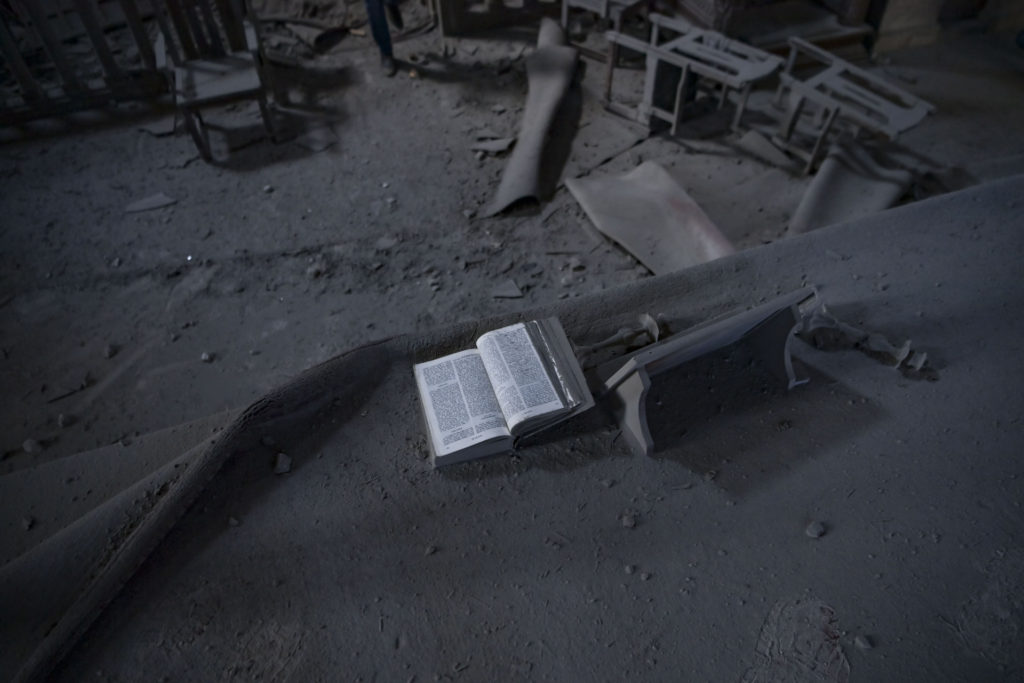
A Bible lies open on an altar on October 8, 2020 inside the damaged Ghazanchetsots (Holy Saviour) Cathedral in the historic city of Shusha, some 15 kilometres from the disputed Nagorno-Karabakh province’s capital Stepanakert, that was hit by a bomb as fighting between Armenian and Azerbaijani forces spilled over today ahead of a first meeting of international mediators in Geneva. Nagorno-Karabakh broke away from Azerbaijan in a 1990s war that claimed the lives of some 30,000 people. The Armenian separatists declared independence, but no countries recognise its autonomy and it is still acknowledged by world leaders as part of Azerbaijan. (Photo by ARIS MESSINIS / AFP) (Photo by ARIS MESSINIS/AFP via Getty Images)

A Bible lies open on an altar as journalists report on October 8, 2020 inside the damaged Ghazanchetsots (Holy Saviour) Cathedral in the historic city of Shusha, some 15 kilometres from the disputed Nagorno-Karabakh province’s capital Stepanakert, that was hit by a bomb as fighting between Armenian and Azerbaijani forces spilled over today ahead of a first meeting of international mediators in Geneva. Nagorno-Karabakh broke away from Azerbaijan in a 1990s war that claimed the lives of some 30,000 people. The Armenian separatists declared independence, but no countries recognise its autonomy and it is still acknowledged by world leaders as part of Azerbaijan. (Photo by ARIS MESSINIS / AFP) (Photo by ARIS MESSINIS/AFP via Getty Images)
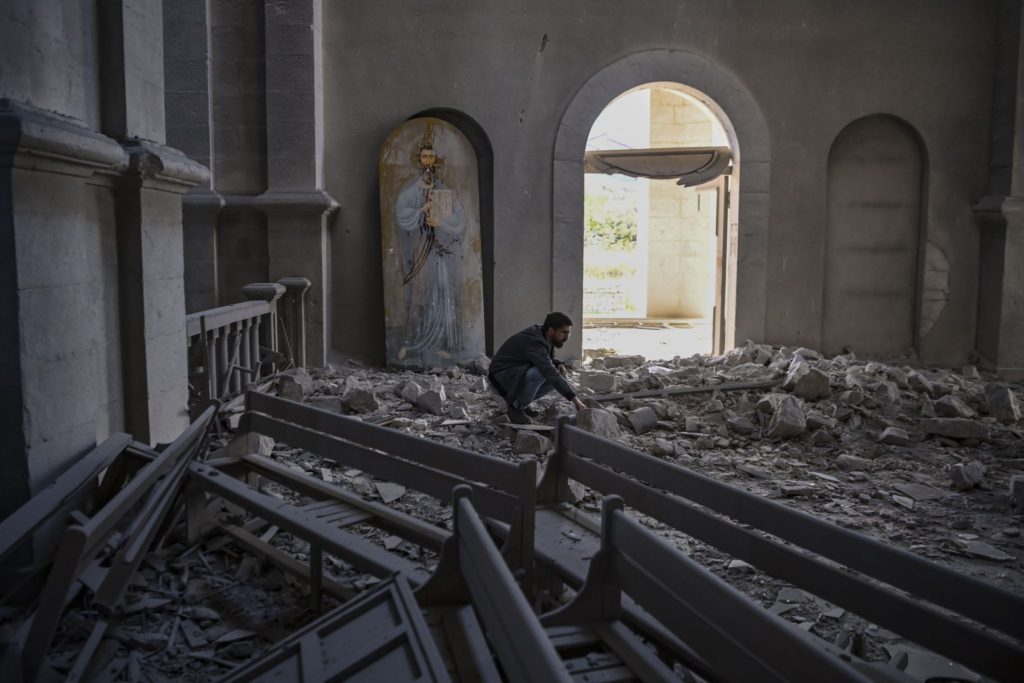
A man stands in the rubble and debris on October 8, 2020 inside the damaged Ghazanchetsots (Holy Saviour) Cathedral in the historic city of Shusha, some 15 kilometres from the disputed Nagorno-Karabakh province’s capital Stepanakert, that was hit by a bomb as fighting between Armenian and Azerbaijani forces spilled over today ahead of a first meeting of international mediators in Geneva. Nagorno-Karabakh broke away from Azerbaijan in a 1990s war that claimed the lives of some 30,000 people. The Armenian separatists declared independence, but no countries recognise its autonomy and it is still acknowledged by world leaders as part of Azerbaijan. (Photo by ARIS MESSINIS / AFP) (Photo by ARIS MESSINIS/AFP via Getty Images)
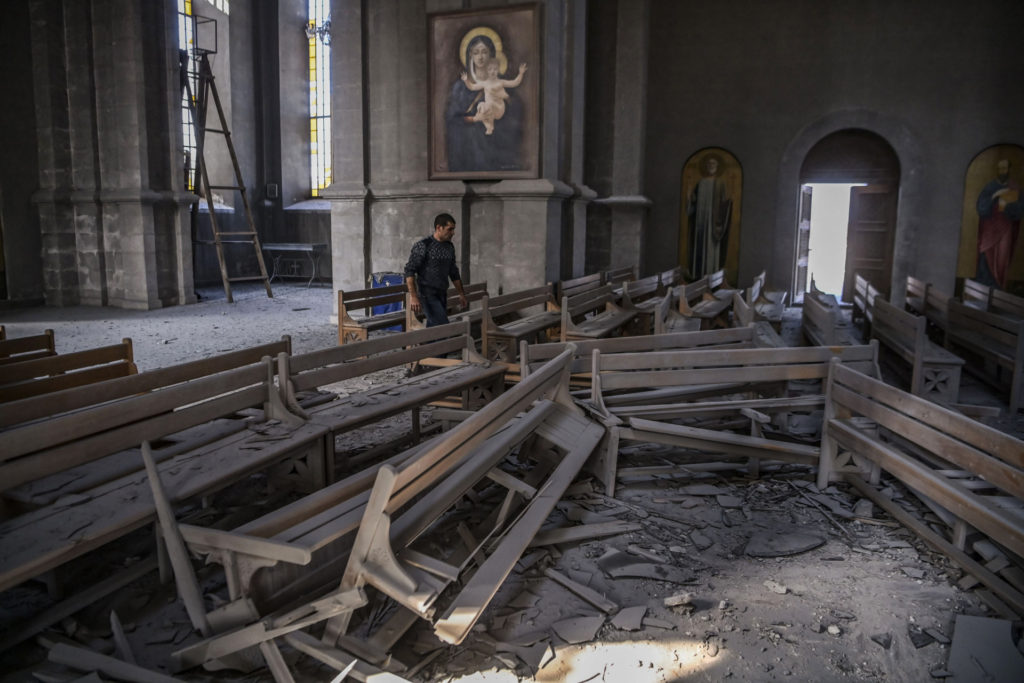
A man walks in rubbles on October 8, 2020 inside the Ghazanchetsots (Holy Saviour) Cathedral in the historic city of Shusha, some 15 kilometres from the disputed Nagorno-Karabakh province’s capital Stepanakert, that was hit by a bomb as fighting between Armenian and Azerbaijani forces spilled over today ahead of a first meeting of international mediators in Geneva. Nagorno-Karabakh broke away from Azerbaijan in a 1990s war that claimed the lives of some 30,000 people. The Armenian separatists declared independence, but no countries recognise its autonomy and it is still acknowledged by world leaders as part of Azerbaijan. (Photo by ARIS MESSINIS / AFP) (Photo by ARIS MESSINIS/AFP via Getty Images)

Journalists and local inhabitants stand on October 8, 2020 inside the damaged Ghazanchetsots (Holy Saviour) Cathedral in the historic city of Shusha, some 15 kilometres from the disputed Nagorno-Karabakh province’s capital Stepanakert, that was hit by a bomb as fighting between Armenian and Azerbaijani forces spilled over today ahead of a first meeting of international mediators in Geneva. Nagorno-Karabakh broke away from Azerbaijan in a 1990s war that claimed the lives of some 30,000 people. The Armenian separatists declared independence, but no countries recognise its autonomy and it is still acknowledged by world leaders as part of Azerbaijan. (Photo by ARIS MESSINIS / AFP) (Photo by ARIS MESSINIS/AFP via Getty Images)
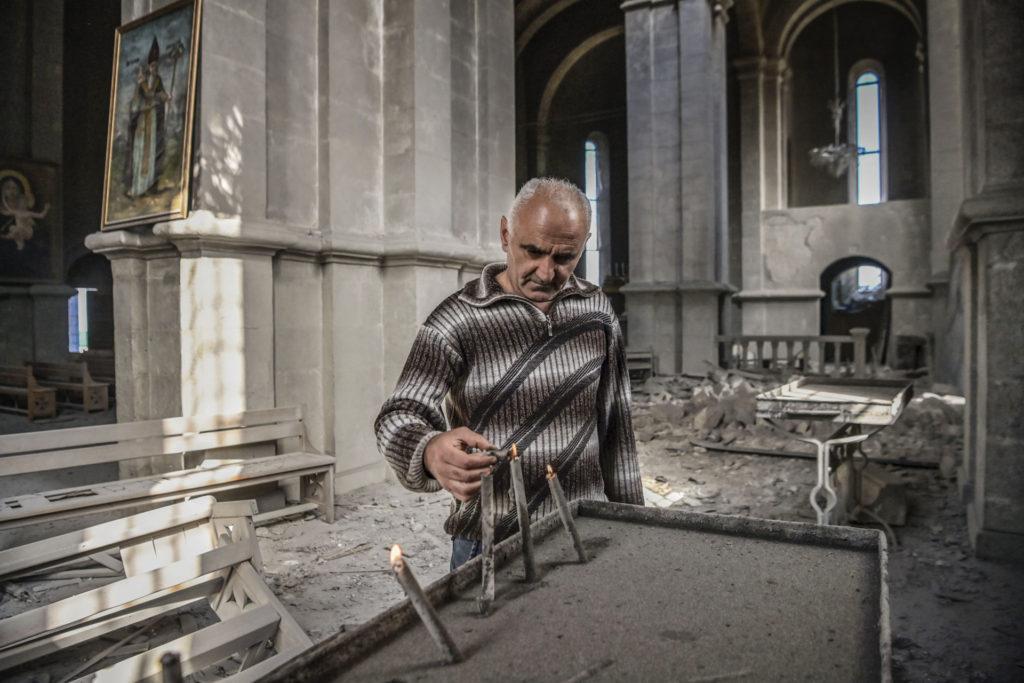
TOPSHOT – A man lights a candle on October 8, 2020 inside the damaged Ghazanchetsots (Holy Saviour) Cathedral in the historic city of Shusha, some 15 kilometres from the disputed Nagorno-Karabakh province’s capital Stepanakert, that was hit by a bomb as fighting between Armenian and Azerbaijani forces spilled over today ahead of a first meeting of international mediators in Geneva. Nagorno-Karabakh broke away from Azerbaijan in a 1990s war that claimed the lives of some 30,000 people. The Armenian separatists declared independence, but no countries recognise its autonomy and it is still acknowledged by world leaders as part of Azerbaijan. (Photo by ARIS MESSINIS / AFP) (Photo by ARIS MESSINIS/AFP via Getty Images)
Jihadists regularly targeted churches at the height of the many-sided conflict in Syria, killing or displacing local, often historic Christian populations in large numbers.
The Syrian Observatory for Human Rights, a Britain-based war monitoring organisation critical of Syrian president Bashar al-Assad and his Russian backers, claims that Turkish president Recep Tayyip Erdogan has sent around 1,200 Syrian fighters into the Nagorno-Karabakh conflict zone to support the Azeris.
Follow Jack Montgomery on Twitter: @JackBMontgomery
Follow Breitbart London on Facebook: Breitbart London
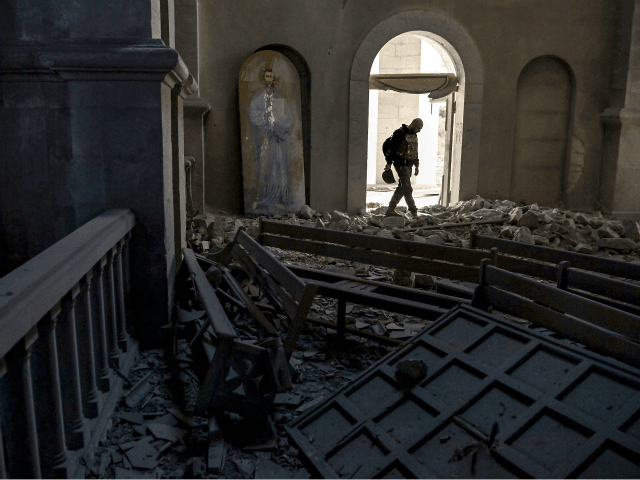
COMMENTS
Please let us know if you're having issues with commenting.